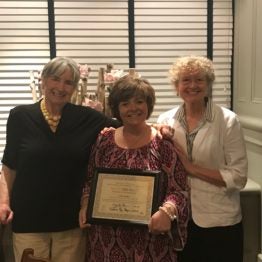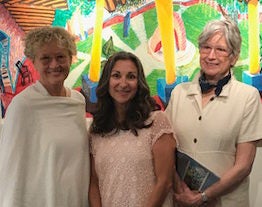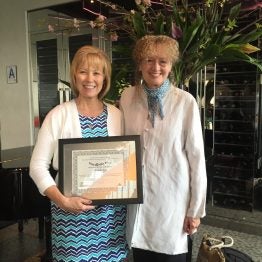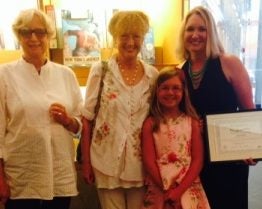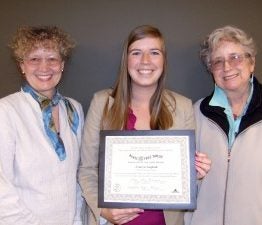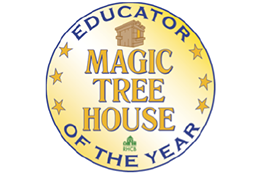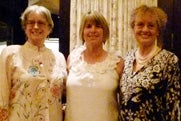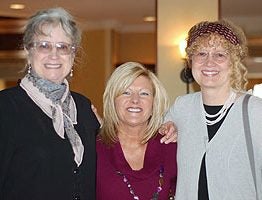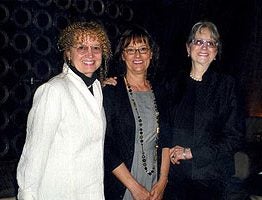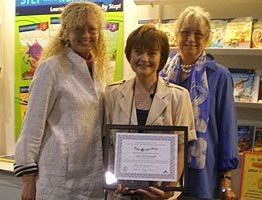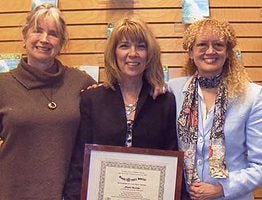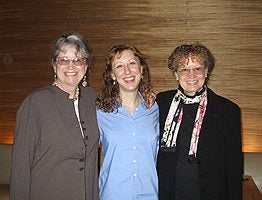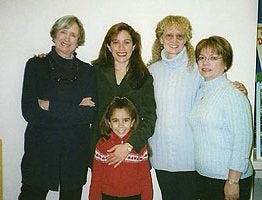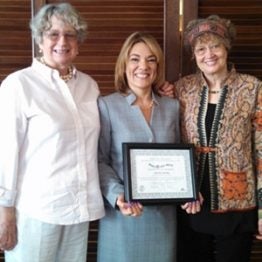 Martha Basulto meets Mary Pope
Osborne and Natalie
Pope Boyce.
Martha Basulto meets Mary Pope
Osborne and Natalie
Pope Boyce.
Martha Basulto
Coral Reef Elementary
Miami, Florida
I have always been in love with the Magic Tree House series and I believe it is one of the most exciting and most educational series for young children. I teach Reading and Language Arts to first grade gifted and I use the Magic Tree House books as a supplemental literature to help children increase vocabulary, fluency, integrate knowledge and ideas, develop reading comprehension, listening, speaking and writing skills, identify key ideas and details, expand phonological awareness, etc.
I built a tree house in my room and I created a lovely reading area to inspire young minds to learn. My theme is “Around the World in Mrs. Basulto’s Class” and we use the tree house to travel around the world. During the school year we visit all the continents and different countries within the continents. The tree house has a steering wheel and every time we are off to a new adventure we spin the wheel and we pretend the tree house spins. We also decorate the tree house according to the place we are visiting.
The first continents we visit are South America and North America. The reason why we visit these continents first is because we go to South America and North America to celebrate Hispanic Heritage (September 15-October 15). Then we read Afternoon on the Amazon. The children learn about the culture and customs of Hispanic countries. Each group is given a country and an animal from that country to study and research. We go to the computer lab and we find information about the country and the animal. The students have the opportunity to participate in collaborative conversations while doing the research (Comprehension and Collaboration). They use their science journal to write the information they find (language, clothing, food, flag, living habitat of the animal, etc). When they have all the pertinent information they display it on a trifold board for a presentation. I also help them put the information in a power point presentation (Production and Distribution of Writing). As a culminating activity other classes are invited to come to listen to their research and presentation (Research to Build and Present Knowledge). The children also dress in the typical clothing of the country they are representing and they dance the country typical dance. We also eat the typical food from those countries as part of the science curriculum. We make tacos in class to help children understand how matter changes and we talk about liquids, solids and gases. While cooking the meat for the tacos the children can experience the change. We also talk about condensation and evaporation. This helps children make a real life connection with what they are learning.
We also read Haunted Castle on Hallows Eve (Halloween), Thanksgiving on Thursday (Thanksgiving), Eve of the Emperor Penguin (Winter/Antarctica), Day of the Dragon King (Asia), Lions at Lunch Time (Africa), Leprechaun in Late Winter (Europe), and Dingoes at Dinnertime (Australia). Every time we visit a continent the students get a stamp in their Reading Passport.
Every time we read a Magic Tree House book I integrate Reading, Writing, Science, Social Studies (mapping skills), and Math. I believe that integrating all subjects areas into one thematic unit help students make the connection they need to understand concepts. Each student has his/her own copy of the book. When we read the book together the students do annotations on the book. We look for conjunctions, verbs, possessives pronouns, adjectives, singular and plural nouns, prepositions, interrogative, imperative and exclamatory sentences (Conventions of Standard English), etc. I also clarify the meaning of unknown words by using context clues (Vocabulary). The students can highlight the word and write its meaning. We also write plays about the book to retell the story in the children’s own words and we perform for other classes. While retelling the story the students describe the characters, setting(s), and major events in the story (Key Ideas and Details). While writing the plays the children are encouraged to use proper punctuation and capitalization (Print Concepts), spell words phonetically to help them demonstrate understanding of spoken words, syllables and sounds. Performing the plays also help them develop fluency skills (Fluency). The children are also encouraged to create their own props and costumes to express their ideas and feelings (Presentation of Knowledge and Ideas).
After I read each chapter out loud, the children do choral reading and individual reading to help them develop fluency. Then they visit the tree house and listen to the chapter again on the I-pod and they complete different reading comprehension activities. These activities include graphic organizers to do sequence of events (Text Types and Purposes), describe the places we have visited, compare and contrast Jack and Annie adventures (Integration of knowledge and Ideas), etc. After they finish reading all the chapters they take an Accelerated Reader test to check comprehension.
We also participate in an international community project (Heifer International) when we visit Africa. We join a reading program called “Read to Feed.” I encourage children to read Magic Tree House books and I ask their families to get sponsors for each book they read. At the end of the program, the group pools its funds and donates them To Heifer International to help Heifer assist needy families. This program provides the students with knowledge that will help them understand the connection between people, their actions and the environment.
Another great program I use in connection with the Magic Tree House books is Odyssey of the Mind. The structure of Odyssey of the Mind is a perfect counterpart for the demands of the Common Core since students are taught how to apply knowledge through higher order thinking. I use Odyssey of the Mind strategies while reading the Magic Tree House books to help students respond to questions quickly and creatively. I also encourage the depth of thinking.
I integrate math by utilizing estimation of time when traveling in the tree house. We pretend we start traveling when we start reading a chapter. I write the time on the board (Tell and Write Time). When we finish reading the chapter we annotate the time. The children have to tell me how much time has passed. I also encourage the students to write addition and subtraction stories based on major events of the story (Represent and Solve Problems Involving Addition and Subtraction). We sometimes use legos to represent the stories. When we read “Eve of the Emperor Penguin” we research and compare heights of famous mountains by using graph paper (Measurement and Data).
I have a world map in my room and every time we visit a continent we pin Jack and Annie (paper dolls) on that continent.


